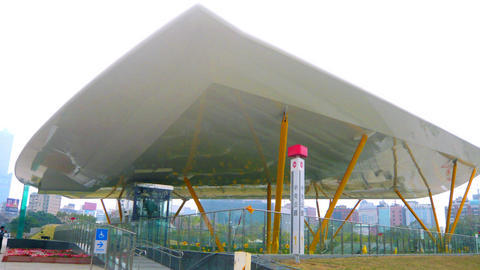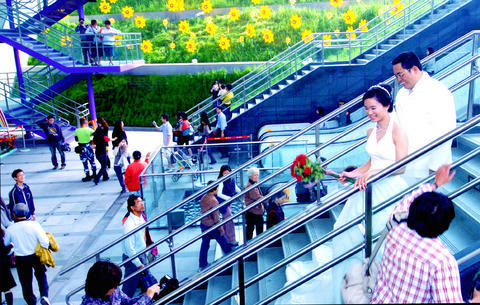As many as 210,000 people packed the stations of the Kaohsiung Mass Rapid Transit (MRT) system's Red Line following its official opening on Sunday afternoon.
Non-Kaohsiung residents might find it difficult to understand why witnessing the launch of the MRT line on Sunday was such a spine-tingling experience for local residents.
For people in the nation's second-biggest city, the concept of "public transportation" never really meant much.

PHOTO: FLORA WANG, TAIPEI TIMES
The city has some 400 buses running on 92 routes and limited coaches providing service to passengers traveling to the townships of Kaohsiung and Pingtung counties.
However, using the bus system has always been a painful experience for people in Kaohsiung, with many saying it is an inefficient and inconvenient way to get around.
"In the past, we usually had to wait at the bus stop for more than 30 minutes before a bus came," said Ivy Lee (

PHOTO: CHANG CHUNG-YI, TAIPEI TIMES
Lee's experience is shared by many.
Even following years of efforts by the city government to improve the bus system, it still takes about 90 minutes to travel from the southern part of the city -- Kaohsiung International Airport, for example -- to Nanzih (
But the MRT north-south Red Line is about to change all that.
During a tour of the Red Line for the media on Friday, Vivian Wu (吳孟嬪), junior administrator of the Kaohsiung Rapid Transit Corp's (KRTC) Public Affairs Department's Media Communication Section, said that traveling from one end of the Red Line to the other -- from Xiaogang (小港) to Chiaotou (橋頭) in Kaohsiung County (the Gangshan [岡山] South Station, the last stop in the north end, is still under construction) -- takes about 45 minutes.
After a six-year-and-four-month wait, Kaohsiung residents' dream of an efficient public transport system has finally come true.
The Red Line is the nation's first rapid transit route to provide a direct link to an international airport, a major Taiwan Railway station, a high speed rail station and a ferry station.
The construction of the entire system, including the Red Line and the east-to-west Orange Line, began on Oct. 24, 2001.
The NT$181.5 billion (US$5.9 billion) system was scheduled to begin operation on Oct. 20 last year, but several cave-ins during construction of the Orange Line delayed progress.
The maiden voyage, spanning seven stops on the northern part of the Red Line, was held during the Lunar New Year holiday.
As Deputy Kaohsiung Mayor Chiu Tai-san (邱太三) told journalists from Taipei on Thursday, the free Lunar New Year ride attracted 400,000 people over four days.
Kaohsiung residents were also treated to the system's unique and ingenious fusion of art and public transport for the first time over the weekend following the illumination of the world's largest public glass art work -- the Dome of Light -- at the Formosa Boulevard Station on Friday.
"We hope the experience of the artwork at KRTC stations is something passengers will take home with them," Chiu said, adding that this was the main difference between the rapid transit systems in Taipei and Kaohsiung.
Indeed, art, or more specifically glass arkwork created by renowned international artists such as Italian maestro Narcissus Quagliata -- the creator of the dome -- and German-born artist Lutz Haufschild are the additional highlights of a tour of the transit route.
Passengers arriving at the city by air will immediately be taken by the world's largest 3D glass sculpture -- the Emerald Laminata -- created by Haufschild on the walls at the Kaohsiung International Airport Station.
Unlike artifacts in a museum, the artwork is easily accessible and touchable.
"In society, most of the things are for utility, for being used. The use of art is to teach people
how to enjoy their life," Quagliata told the Taipei Times.
"Kaohsiung is undergoing a major transformation from an industrial city to a city focusing on recreation and culture," Chiu said.
That transformation, however, is expected to take years because the inefficient bus transport system has created a unique commuting culture in Kaohsiung.
Statistics from the city's Bureau of Transportation showed that the utility rate of the city's public transportation system has been stable at 5 percent over the past several decades.
The city, with a population of 1.5 million people, has the largest number of registered scooters in Taiwan -- about 1.2 million.
"Scooters are very convenient for getting around downtown. It may be faster and more comfortable to ride on the MRT, but I have become accustomed to getting around by scooter. I can also go many places that the MRT does not go to," Lee said.
Wang E-cheng (
"To me, the MRT is more like a convenient means of transportation for people visiting Kaohsiung," Wang said.
Chiu acknowledged the difficulty in changing people's perception of public transportation.
"We must provide residents with incentives [to take the rapid transit system] to change their lifestyle," Chiu said, adding that the city government has launched shuttle buses services to and from the MRT stations.
He told the Taipei Times that the city government was also considering reducing the number of scooters on the roads by clamping down on illegal parking and on scooters that cause too much pollution.

An essay competition jointly organized by a local writing society and a publisher affiliated with the Chinese Communist Party (CCP) might have contravened the Act Governing Relations Between the People of the Taiwan Area and the Mainland Area (臺灣地區與大陸地區人民關係條例), the Mainland Affairs Council (MAC) said on Thursday. “In this case, the partner organization is clearly an agency under the CCP’s Fujian Provincial Committee,” MAC Deputy Minister and spokesperson Liang Wen-chieh (梁文傑) said at a news briefing in Taipei. “It also involves bringing Taiwanese students to China with all-expenses-paid arrangements to attend award ceremonies and camps,” Liang said. Those two “characteristics” are typically sufficient

A magnitude 5.9 earthquake that struck about 33km off the coast of Hualien City was the "main shock" in a series of quakes in the area, with aftershocks expected over the next three days, the Central Weather Administration (CWA) said yesterday. Prior to the magnitude 5.9 quake shaking most of Taiwan at 6:53pm yesterday, six other earthquakes stronger than a magnitude of 4, starting with a magnitude 5.5 quake at 6:09pm, occurred in the area. CWA Seismological Center Director Wu Chien-fu (吳健富) confirmed that the quakes were all part of the same series and that the magnitude 5.5 temblor was

The brilliant blue waters, thick foliage and bucolic atmosphere on this seemingly idyllic archipelago deep in the Pacific Ocean belie the key role it now plays in a titanic geopolitical struggle. Palau is again on the front line as China, and the US and its allies prepare their forces in an intensifying contest for control over the Asia-Pacific region. The democratic nation of just 17,000 people hosts US-controlled airstrips and soon-to-be-completed radar installations that the US military describes as “critical” to monitoring vast swathes of water and airspace. It is also a key piece of the second island chain, a string of

The Central Weather Administration has issued a heat alert for southeastern Taiwan, warning of temperatures as high as 36°C today, while alerting some coastal areas of strong winds later in the day. Kaohsiung’s Neimen District (內門) and Pingtung County’s Neipu Township (內埔) are under an orange heat alert, which warns of temperatures as high as 36°C for three consecutive days, the CWA said, citing southwest winds. The heat would also extend to Tainan’s Nansi (楠西) and Yujing (玉井) districts, as well as Pingtung’s Gaoshu (高樹), Yanpu (鹽埔) and Majia (瑪家) townships, it said, forecasting highs of up to 36°C in those areas